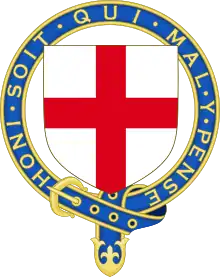Peter Carington, 6th Baron Carrington
Peter Alexander Rupert Carington, 6th Baron Carrington, Baron Carington of Upton, KG, GCMG, CH, MC, PC, DL (6 June 1919 – 9 July 2018), was a British Conservative politician and hereditary peer who served as defence secretary from 1970 to 1974, foreign secretary from 1979 to 1982, chairman of British General Electric Company from 1983 to 1984, and secretary general of NATO from 1984 to 1988. In the first government of Margaret Thatcher, he played a major role in negotiating the Lancaster House Agreement that ended the racial conflict in Rhodesia and enabled the creation of Zimbabwe.
The Lord Carrington | |||||||||||||||||||||||||||||||||||||||||||||||||||||||||||||||||||||||||||||||||||||||||||||||||||||||
|---|---|---|---|---|---|---|---|---|---|---|---|---|---|---|---|---|---|---|---|---|---|---|---|---|---|---|---|---|---|---|---|---|---|---|---|---|---|---|---|---|---|---|---|---|---|---|---|---|---|---|---|---|---|---|---|---|---|---|---|---|---|---|---|---|---|---|---|---|---|---|---|---|---|---|---|---|---|---|---|---|---|---|---|---|---|---|---|---|---|---|---|---|---|---|---|---|---|---|---|---|---|---|---|
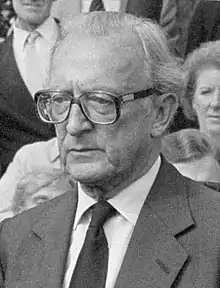 Carrington in 1984 | |||||||||||||||||||||||||||||||||||||||||||||||||||||||||||||||||||||||||||||||||||||||||||||||||||||||
| 6th Secretary General of NATO | |||||||||||||||||||||||||||||||||||||||||||||||||||||||||||||||||||||||||||||||||||||||||||||||||||||||
| In office 25 June 1984 – 1 July 1988 | |||||||||||||||||||||||||||||||||||||||||||||||||||||||||||||||||||||||||||||||||||||||||||||||||||||||
| Preceded by | Joseph Luns | ||||||||||||||||||||||||||||||||||||||||||||||||||||||||||||||||||||||||||||||||||||||||||||||||||||||
| Succeeded by | Manfred Wörner | ||||||||||||||||||||||||||||||||||||||||||||||||||||||||||||||||||||||||||||||||||||||||||||||||||||||
| Secretary of State for Foreign and Commonwealth Affairs | |||||||||||||||||||||||||||||||||||||||||||||||||||||||||||||||||||||||||||||||||||||||||||||||||||||||
| In office 4 May 1979 – 5 April 1982 | |||||||||||||||||||||||||||||||||||||||||||||||||||||||||||||||||||||||||||||||||||||||||||||||||||||||
| Prime Minister | Margaret Thatcher | ||||||||||||||||||||||||||||||||||||||||||||||||||||||||||||||||||||||||||||||||||||||||||||||||||||||
| Preceded by | David Owen | ||||||||||||||||||||||||||||||||||||||||||||||||||||||||||||||||||||||||||||||||||||||||||||||||||||||
| Succeeded by | Francis Pym | ||||||||||||||||||||||||||||||||||||||||||||||||||||||||||||||||||||||||||||||||||||||||||||||||||||||
| |||||||||||||||||||||||||||||||||||||||||||||||||||||||||||||||||||||||||||||||||||||||||||||||||||||||
| Member of the House of Lords | |||||||||||||||||||||||||||||||||||||||||||||||||||||||||||||||||||||||||||||||||||||||||||||||||||||||
| In office 6 June 1940 – 9 July 2018 Hereditary peerage | |||||||||||||||||||||||||||||||||||||||||||||||||||||||||||||||||||||||||||||||||||||||||||||||||||||||
| Personal details | |||||||||||||||||||||||||||||||||||||||||||||||||||||||||||||||||||||||||||||||||||||||||||||||||||||||
| Born | Peter Alexander Rupert Carington 6 June 1919 Chelsea, London, England | ||||||||||||||||||||||||||||||||||||||||||||||||||||||||||||||||||||||||||||||||||||||||||||||||||||||
| Died | 9 July 2018 (aged 99) London, England | ||||||||||||||||||||||||||||||||||||||||||||||||||||||||||||||||||||||||||||||||||||||||||||||||||||||
| Political party | Conservative | ||||||||||||||||||||||||||||||||||||||||||||||||||||||||||||||||||||||||||||||||||||||||||||||||||||||
| Spouse(s) | Iona McClean
(m. 1942; died 2009) | ||||||||||||||||||||||||||||||||||||||||||||||||||||||||||||||||||||||||||||||||||||||||||||||||||||||
| Children | 3, including Rupert | ||||||||||||||||||||||||||||||||||||||||||||||||||||||||||||||||||||||||||||||||||||||||||||||||||||||
| Parents | Rupert Carington, 5th Baron Carrington The Hon. Sybil Marion Colville | ||||||||||||||||||||||||||||||||||||||||||||||||||||||||||||||||||||||||||||||||||||||||||||||||||||||
| Alma mater | Royal Military College, Sandhurst | ||||||||||||||||||||||||||||||||||||||||||||||||||||||||||||||||||||||||||||||||||||||||||||||||||||||
| Military service | |||||||||||||||||||||||||||||||||||||||||||||||||||||||||||||||||||||||||||||||||||||||||||||||||||||||
| Allegiance | |||||||||||||||||||||||||||||||||||||||||||||||||||||||||||||||||||||||||||||||||||||||||||||||||||||||
| Branch/service | |||||||||||||||||||||||||||||||||||||||||||||||||||||||||||||||||||||||||||||||||||||||||||||||||||||||
| Years of service | 1939–1949 (inactive from 1945) | ||||||||||||||||||||||||||||||||||||||||||||||||||||||||||||||||||||||||||||||||||||||||||||||||||||||
| Rank | Major | ||||||||||||||||||||||||||||||||||||||||||||||||||||||||||||||||||||||||||||||||||||||||||||||||||||||
| Unit | Grenadier Guards | ||||||||||||||||||||||||||||||||||||||||||||||||||||||||||||||||||||||||||||||||||||||||||||||||||||||
| Battles/wars | Second World War | ||||||||||||||||||||||||||||||||||||||||||||||||||||||||||||||||||||||||||||||||||||||||||||||||||||||
| Awards | Military Cross | ||||||||||||||||||||||||||||||||||||||||||||||||||||||||||||||||||||||||||||||||||||||||||||||||||||||
Carrington had been Foreign Secretary in 1982 when Argentina invaded the Falkland Islands. He took full responsibility for the failure to foresee this and resigned. As NATO secretary general, he helped prevent a war between Greece and Turkey during the 1987 Aegean crisis.[1]
Following the House of Lords Act 1999, which removed the automatic right of hereditary peers to sit in the House of Lords, Carrington was created a life peer as Baron Carington of Upton.
Background and early life
The surname "Carrington" (with two r's) was adopted by royal licence dated 1839 by his direct male ancestor Robert Carrington, 2nd Baron Carrington, in lieu of Smith.[2] The latter's father, Robert Smith, MP for Nottingham, was created Baron Carrington in 1796 (Peerage of Ireland) and 1797 (Peerage of Great Britain).[3] The spelling of the surname was changed by royal licence to "Carington" (with one r) in 1880 by the 2nd Baron's sons, but the spelling of the title did not change.
Born in Chelsea on 6 June 1919,[4][5] Peter Alexander Rupert Carington[6] was the only son of the 5th Baron Carrington by his wife, the Hon. Sybil Marion Colville, a daughter of Charles Colville, 2nd Viscount Colville of Culross.[7] He was a great-nephew of the Liberal statesman Charles Wynn-Carington, 1st Marquess of Lincolnshire, and also of politician and courtier the Hon. Sir William Carington. Brought up at the Millaton House in Devon,[8] he was educated at two independent schools: Sandroyd School from 1928 to 1932,[9] based at the time in the town of Cobham, Surrey (now the site of Reed's School), and Eton College. Upon leaving Eton, his housemaster said of him, "For a really stupid boy, there are three possible professions: farming, soldiering and stockbroking".[6]
Military service
Having trained at the Royal Military College, Sandhurst, Carrington was commissioned into the Grenadier Guards as a second lieutenant on 26 January 1939.[10] He served with the regiment during the Second World War, and played a key role as a tank commander during Operation Market Garden in the Netherlands in 1944. He was promoted to lieutenant on 1 January 1941,[11] and later rose to the rank of temporary captain[12] and acting major. He was awarded the Military Cross (MC) on 1 March 1945 "in recognition of gallant and distinguished services in North West Europe".[13][12] After the war, Carrington remained in the army until 1949.[14]
Political career 1946–1982
In 1938, Carrington succeeded his father as 6th Baron Carrington. Although he became eligible to take his seat in the House of Lords on his 21st birthday in 1940, he was on active service at the time, and did not do so until 9 October 1945.[15] After leaving the Army, he became involved in politics and served in the Conservative governments of Winston Churchill and Anthony Eden as Parliamentary Secretary to the Minister of Agriculture and Food from November 1951 to October 1954. During the Crichel Down affair, which led to the resignation of Minister Thomas Dugdale, Carrington tendered his resignation, which was refused by the Prime Minister. Carrington then became Parliamentary Secretary to the Minister of Defence from October 1954 to October 1956. The latter year he was appointed High Commissioner to Australia, a post he held until October 1959. He was also appointed a Deputy Lieutenant of Buckinghamshire on 2 July 1951.[16] He became a Privy Counsellor in 1959.[17]
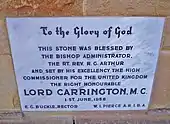
After his return to Britain he served under Harold Macmillan as First Lord of the Admiralty until October 1963.[18] These were the years of the Royal Navy's Indian summer, and Carrington completed his education in high level defence, largely playing a secondary role, with former CNS Lord Mountbatten, 'Burma' to even other Sea Lords, as the last Royal CDS achieving the restoration of the Royal Navy to equal status with the Army and RAF, and securing major ship orders with guided missile destroyers replacing, cruisers, and a large new nuclear submarine and Leander frigate building programme and interim retention of a large carrier programme. Carrington found Mountbatten impossibly vain and unrealistic in his pretensions, but thought, aircraft carriers and amphibious task force allowing flexible intervention and crucially easier withdrawal, than land forces, A better idea than the RAF island hopping alternative,[19] as Carrington believed that the Island bases would all have declared independence by 1975. The unrealism of Mountbatten's large CVA01 carrier programme and right wing temporary PM Douglas Home, saw Carrington settle for Minister without Portfolio and Leader of the House of Lords under Alec Douglas-Home until October 1964, when the Conservatives fell from power. From 1964 to 1970 he was Leader of the Opposition in the House of Lords. When the Conservatives returned to power in 1970 under Edward Heath, Carrington became Defence Secretary, where he remained until 1974 when the Conservatives were voted out in favour of Harold Wilson's Labour. In a 1977 letter discussing the policy of torture of Irish republican internees during Operation Demetrius in August 1971, the then Home Secretary Merlyn Rees attributed the origins of the policy in particular to Carrington: '"It is my view (confirmed by Brian Faulkner before his death [NI's prime minister at the time]) that the decision to use methods of torture in Northern Ireland in 1971/72 was taken by ministers – in particular Lord Carrington, then secretary of state for defence."[20][21]
Carrington had become Shadow Defence Secretary in 1968 after Enoch Powell was dismissed from the position following his controversial Rivers of Blood speech on immigration.[22] He also served as Chairman of the Conservative Party from 1972 to 1974, and was briefly Secretary of State for Energy from January to March 1974.

Carrington was again Leader of the Opposition in the House of Lords from 1974 to 1979. In 1979 he was made Foreign Secretary and Minister for Overseas Development as part of the first Cabinet of Margaret Thatcher. Thatcher spoke very highly of Carrington, stating that "Peter had great panache and the ability to identify immediately the main points in any argument; and he could express himself in pungent terms. We had disagreements, but there were never any hard feelings."[23]
Carrington chaired the Lancaster House conference in 1979, attended by Ian Smith, Abel Muzorewa, Robert Mugabe, Joshua Nkomo and Josiah Tongogara, which brought to an end Rhodesia's Bush War. He later expressed his support for Mugabe over Smith.[24]
Carrington was Foreign Secretary when Argentina invaded the Falkland Islands on 2 April 1982. He resigned from the position on 5 April, taking full responsibility for the complacency of the Foreign and Commonwealth Office in its failure to foresee this development[25] and for the misleading signals sent by the Foreign Office on British intentions for retaining control over the Falklands.[26] In her autobiography, Margaret Thatcher was later to express her sorrow at his departure.[27] She had asked him to stay but he left because he and the Foreign Office was distrusted even hated by many back-bench Conservatives, and in turn he despised the party for its pettiness.[28] Since his resignation, no other member of the House of Lords has held any of the four Great Offices of State.[29]
Later life and death
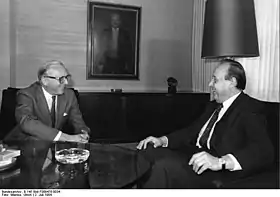
Lord Carrington then served as Secretary General of NATO from 1984 to 1988. He was also appointed Chancellor of the Order of St Michael and St George on 1 August 1984,[30] serving until June 1994.[31]
In 1991, he presided over diplomatic talks about the breakup of Yugoslavia and attempted to pass a plan that would end the wars and result in each republic becoming an independent nation.[32]
Apart from his political posts, he was the Chancellor of the University of Reading and served as chairman of several companies, including Christie's, and as a director of many others, including Barclays Bank, Schweppes and The Daily Telegraph. He also chaired the Bilderberg conferences from 1990 to 1998, being succeeded in 1999 by Étienne Davignon.[33] From 1983 to 2002, he was president of the Pilgrims Society,[34][35] and from 1971 to 2018 the President of the Britain–Australia Society.[36] He was appointed Chancellor of the Order of the Garter on 8 November 1994,[37] a role from which he retired in October 2012.[38]
After the House of Lords Act 1999 removed the automatic right of hereditary peers to sit in the House of Lords, Carrington, along with all former leaders of the House of Lords, was given a life peerage on 17 November 1999 as Baron Carington of Upton, of Upton in the County of Nottinghamshire.[39] He was the longest-serving member of the House of Lords, and following the retirement of Lord Barber of Tewkesbury in 2016, had been the oldest. He was the second longest-serving member of the Privy Council after the Duke of Edinburgh.
He died on 9 July 2018, aged 99, of natural causes[40][41][4] in London;[42] his son Rupert succeeded him as 7th Baron Carrington.[6]
Family
Lord Carrington married Iona McClean (19 March 1920 – 7 June 2009), daughter of Lt Col. Sir Francis Kennedy McClean AFC and Aileen Wale, on 25 April 1942. They had three children: Alexandra de Bunsen DL (born 1943), Virginia Carington LVO (born 1946; formerly married to Lord Ashcombe),[43] and Rupert Carington, 7th Baron Carrington DL (born 1948). Lord Carrington's wife, Lady Carrington, died on 7 June 2009, aged 89.[44]
In popular culture
Carrington was a guest on BBC Radio 4's long-running programme Desert Island Discs in 1975[45] and on the same station's A Good Read in 2004.[46]
In February 1982 Carrington was portrayed by Rowan Atkinson in a Not the Nine O'Clock News parody of Question Time, pedantically discussing an imminent nuclear holocaust.[47][48]
Carrington was portrayed by James Fox in the 2002 BBC production of Ian Curteis's The Falklands Play.[49] He was also briefly portrayed by James Smith in the 2011 film The Iron Lady,[50] and by Jeff Rawle in the 2014 play Handbagged.[51]
Honours
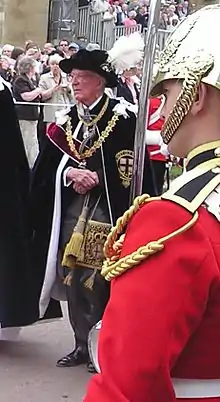
- 1945: Military Cross
- 1958:[52] Knight Commander of the Most Distinguished Order of Saint Michael and Saint George (KCMG)
- 1959: Lord of Her Majesty's Most Honourable Privy Council
- 1983:[53] Companion of the Order of the Companions of Honour (CH)
- 1985:[54] Knight Companion of the Most Noble Order of the Garter (KG); Chancellor of the Order[37] (1994–2012)
- 1988:[55] Knight Grand Cross of the Most Distinguished Order of Saint Michael and Saint George (GCMG); Chancellor of the Order[30] (1984–1994)[56]
- 1999:[39] Life peerage, as Baron Carington of Upton
- Knight Grand Cross of the Royal and Distinguished Spanish Order of Charles III[57]
- 1988:[58] Presidential Medal of Freedom
- Department of Defense Medal for Distinguished Public Service
- Freedom of the City of London
Honorary degrees
- 1981:[59] University of Cambridge (LL.D)
- 1983:[60] University of Essex (DUniv)
- December 1989:[61][62] University of Reading (DLitt)
- 1986:[63] Harvard University (LLD)
- 1993:[64] University of Nottingham (LLD)
- 14 December 1998:[65] University of Newcastle upon Tyne (DCL)
- 21 November 2003:[66] University of Oxford (DCL)
Arms
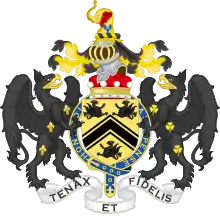 |
|
Bibliography
- Reflect on Things Past – The Memoirs of Lord Carrington. Published by William Collins, 1988.[71]
References
- Alan Cowell (29 March 1987). "Greeks and Turks ease Aegean crisis". The New York Times. Retrieved 2 July 2017.
- Cokayne, and others, The Complete Peerage, volume II, p. 197.
- Kidd, Charles. Debrett's Peerage & Baronetage, 2015 Edition. London, England. p. 220.
- "Peter Carington, Last Survivor of Churchill Govt, Dies at 99". Archived from the original on 10 July 2018. Retrieved 10 July 2018.
- Publications, Europa (10 July 2018). The International Who's Who 2004. Psychology Press. ISBN 9781857432176. Retrieved 10 July 2018 – via Google Books.
- "Lord Carrington – obituary". The Telegraph. 10 July 2018. Retrieved 4 August 2020.
- "Index entry". FreeBMD. ONS. Retrieved 14 November 2017.
- "Check out this property for sale on Rightmove!". Rightmove.co.uk. Retrieved 10 July 2018.
- "Sandroyd School's list of Distinguished Alumni". Sandroyd.org. 27 February 2008. Archived from the original on 28 October 2010. Retrieved 4 November 2010.
- "No. 34593". The London Gazette. 27 January 1939. p. 608.
- "No. 35077". The London Gazette (Supplement). 14 February 1941. p. 954.
- "No. 36961". The London Gazette (Supplement). 27 February 1945. pp. 1173–1175.
- "No. 36961". The London Gazette (Supplement). 27 February 1945. p. 1171.
- "No. 37815". The London Gazette (Supplement). 10 December 1946. p. 2877.
"No. 38636". The London Gazette (Supplement). 10 June 1949. p. 2877.
"No. 38654". The London Gazette (Supplement). 1 July 1949. p. 3231. - Membership and principal office holders. parliament.uk.
- "No. 39278". The London Gazette. 6 July 1951. p. 3687.
- 'List of current Privy Counsellors'. privycouncil.independent.gov.uk.
- "No. 41860". The London Gazette. 3 November 1959. p. 6942.
"No. 41891". The London Gazette. 11 December 1959. p. 7851.
"No. 41966". The London Gazette. 26 February 1960. p. 1451.
"No. 42044". The London Gazette. 27 May 1960. p. 3736.
"No. 42249". The London Gazette. 13 January 1961. p. 263.
"No. 42321". The London Gazette. 7 April 1961. p. 2546.
"No. 42476". The London Gazette. 29 September 1961. p. 7055.
"No. 42504". The London Gazette. 3 November 1961. p. 7931.
"No. 42564". The London Gazette. 5 January 1962. p. 145.
"No. 42909". The London Gazette. 1 February 1963. p. 980.
"No. 42925". The London Gazette. 19 February 1963. p. 1619.
"No. 42995". The London Gazette. 17 May 1963. p. 4217.
"No. 43077". The London Gazette. 9 August 1963. p. 6683. - C. Lee. Carrington. An Honourable Man. Viking. Milton Keynes (2018) pp. 169–70.
- 'British ministers sanctioned torture of NI internees' (5 June 2014).
- 'British government authorised use of torture methods in NI in early 1970s' (5 June 2014).
- "Powell's 'rivers of blood' legacy". BBC News. 18 April 2008.
- Margaret Thatcher (1993). The Downing Street Years. HarperCollins. p. 27. ISBN 0002550490
- Holland, Heidi (February 2009). Dinner with Mugabe: The Untold Story of a Freedom Fighter Who Became a Tyrant. London: Penguin Books. p. 64. ISBN 978-0-14-104079-0.
- Erik J. Evans, Thatcher and Thatcherism (1997), p. 99.
- William Keegan: The dishonourable Boris Johnson has brought us to the brink of catastrophe The Guardian, 15 July 2018.
- Charles Moore, Margaret Thatcher: The Authorized Biography: Volume I: From Grantham to the Falklands (2015), 1:674–75.
- Hugo Young, One of Us: A Biography of Mrs. Thatcher (1989) p 265.
- "Peter Carrington". European Leadership Network.
- "No. 49826". The London Gazette. 3 August 1984. p. 10601.
- "Court Circular". Independent. 10 June 1994.
- "Obituary: Lord Carrington". BBC News. 10 July 2018. Retrieved 6 September 2018.
- Rockefeller, David (2002). Memoirs. Random House. p. 412. ISBN 0-679-40588-7.
- Who's Who. 1999.
- "Centennial History". pilgrimsociety.org.
- "Vale Lord Carrington". britain-australia.org.uk.
- "No. 53843". The London Gazette. 8 November 1994. p. 15625.
- "No. 60301". The London Gazette. 17 October 2012. p. 19937.
- "No. 55676". The London Gazette. 23 November 1999. p. 12466.
- "Ex-foreign secretary Lord Carrington dies". 10 July 2018. Retrieved 10 July 2018 – via www.bbc.co.uk.
- Langdon, Julia (10 July 2018). "Lord Carrington obituary". the Guardian. Retrieved 10 July 2018.
- "Life In Legacy". lifeinlegacy.com.
- "Obituary: Lord Ashcome". The Telegraph. 25 December 2013. Retrieved 28 December 2013.
- "Lady Carrington". The Daily Telegraph. London. 24 June 2009. Retrieved 22 May 2010.
- http://www.bbc.co.uk/radio4/features/desert-island-discs/castaway/9729e626
- https://www.bbc.co.uk/programmes/b0076mxz
- "Not The Nine O'Clock News episode guide, see: Season 4, Episode 4". SOTCAA.
- "Episode 1, Compilations, Not the Nine O'Clock News – BBC Two". BBC. Retrieved 10 July 2018.
- "James Fox". BFI. Retrieved 10 July 2018.
- "Cast – STRAYS". Straysthefilm.com. Retrieved 10 July 2018.
- "Handbagged review – Playful speculation on Thatcher's meetings with the Queen". Guardian. Retrieved 10 July 2018.
- "No. 41404". The London Gazette (Supplement). 3 June 1958. p. 3514.
- "No. 49375". The London Gazette (Supplement). 10 June 1983. p. 19.
- "No. 50104". The London Gazette. 26 April 1985. p. 5844.
- "No. 51365". The London Gazette (Supplement). 10 June 1988. p. 3.
- "No. 53691". The London Gazette. 7 June 1994. p. 8301.
- (in Spanish) "Royal Decree 554/1988, 3 June", Boletín Oficial del Estado, No. 134, 4 June 1988, p. 17360.
- Ronald Reagan: "Remarks on Presenting the Presidential Medal of Freedom to Lord Peter Carrington", 10 May 1988. Online by Gerhard Peters and John T. Woolley, The American Presidency Project.
- "Honorary degrees conferred 1977" (PDF). University of Cambridge. Archived from the original on 6 September 2015.CS1 maint: bot: original URL status unknown (link)
- "Calendar of the University of Essex – Former Chancellors, Vice-Chancellors, Emeritus Professors, Emeritus Librarians, Honorary Fellows and Honorary Graduates of the University". Essex.ac.uk. Archived from the original on 7 October 2012. Retrieved 4 November 2010.
- "Lord Carrington – Chancellor of the University of Reading – University of Reading". Rdg.ac.uk. Retrieved 4 November 2010.
- "honorary graduates of the university of reading – University of Reading". Rdg.ac.uk. Retrieved 4 November 2010.
- "Harvard University Commencement | Some honorary degree recipients". Commencement.harvard.edu. Archived from the original on 24 January 2011. Retrieved 4 November 2010.
- Honorary Graduates of the University of Nottingham. University of Nottingham Archived 7 December 2008 at the Wayback Machine
- "Home Page – Alumni Association – Newcastle University". Ncl.ac.uk. Archived from the original on 6 March 2012. Retrieved 4 November 2010.
- Chancellor's choice: honorary degrees for top 10. University of Oxford (21 November 2003) Archived 14 May 2007 at the Wayback Machine
- Kidd, Charles, Debrett's peerage & Baronetage, 2015 edition, London, 2015, p. 220, with existing addition of "couped", although demi-lions usually shown couped not erased.
- Chesshyre, Hubert (1996), The Friends of St. George's & Descendants of the Knights of the Garter Annual Review 1995/96, VII, p. 287
- Kidd, Charles, Debrett's peerage & Baronetage, 2015 edition, London, 2015, p. 220, amended by existing text adding further clarity, namely "on the body". The charges are here not shown palewise (in a vertical column) as in the blazon. Debrett's blazon makes no mention of beaked etc., or as depicted.
- Burke, John (1832). A General and Heraldic Dictionary of the Peerage and Baronetage... London: H. Colburn and R. Bentley. Volume 1, p. 217. Retrieved 19 December 2013.
- "Reflect On Things Past". goodreads.com. Retrieved 6 September 2018.
Further reading
- Bennett, Harry. "Lord Carrington, 1979–82." in British Foreign Secretaries Since 1974 (Routledge, 2004), pp. 131–154.
- Carrington, Peter Alexander Rupert Carington Baron. Reflect on things past: The memoirs of Lord Carrington (HarperCollins, 1988), a primary source.
- Kedourie, Elie. "False inevitabilities." American Scholar (1990) 59#3, pp. 462–468, review.
- Novak, Andrew. "Face-saving maneuvers and strong third-party mediation: the Lancaster house conference on Zimbabwe-Rhodesia." International Negotiation 14.1 (2009): 149–174. online
- Sharp, Paul. "The Thatcher-Carrington Partnership." in Thatcher’s Diplomacy (Palgrave Macmillan, London, 1997), pp. 30–49.
- Tendi, Blessing-Miles. "Soldiers contra diplomats: Britain’s role in the Zimbabwe/Rhodesia ceasefire (1979–1980) reconsidered." Small Wars & Insurgencies 26.6 (2015): 937–956.
- Yorke, Edmund. "‘A Family Affair’: the Lancaster House Agreement." in Diplomacy at the Highest Level (Palgrave Macmillan, 1996), pp. 200–219.
External links
- Announcement of his taking the oath under his new title at the House of Lords House of Lords minutes of proceedings, 17 November 1999
- Lord Carrington's views on the EU from the Daily Telegraph
- Thatcher's First Cabinet
- Imperial War Museum Interview
- NATO Declassified – Lord Carrington (biography)
- Lord Carrington obituary | Politics | The Guardian

.svg.png.webp)
